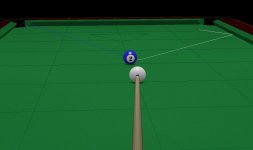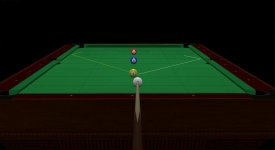Stan,stan shuffett said:Patrick,
The alignment diagram pertains to CTE systems. A first step in CTE is to visually see CTE. Clearly, the CB edges change from shot to shot as well as the OB edges. (I invite everyone to experience this. Just go to a table and set up the shots for A and B and C.) Dr. Dave wrote that the alignment is the same for A,B,C........The only alignment that is common for A, B and C is that they're straight to the center diamond on the end rail. Dr. Dave's alignment statement is in reference to pocketing the balls in the bottom left corner.
Stan
Thank you for responding. I'm sure many people appreciate your involvement ... I certainly do. Here's the diagram again:

As Patrick pointed out, with every shot I want us to consider, the CB and OB both remain on the center line of the table, and the CB and OB are the same distance apart, and the goal is to pocket the OB in the corner pocket. Therefore, the only thing that changes from one shot to another is the angle to the pocket (i.e., the necessary cut angle to make the shot). For simplicity sake, let's assume a center-ball hit on the CB for all shots. Let's also assume the balls are clean and polished and the amount of cut-induced-throw does not vary significantly among the shots we will consider.
The diagram shows the CTE line for each shot "A" through "D". They are all parallel. The diagram also shows that if your cue is aligned and aimed along the CTE line, you will miss all of the shots except shot "A." I am not claiming this is how the popular CTE align-and-pivot systems work. It is just a statement of fact. What we want to know is how the angle to the pocket is taken into consideration for different shots like the ones in the diagram. More specifically, how do you create the subtle changes in aim necessary (e.g., with where and how you place your bridge hand and/or how you pivot to center) for different shots when the CB-OB relationship is the same for those shots (i.e., the CB and OB are just being shifted slightly, and together, so only the required angle to the pocket is slightly different)?
In particular, I was hoping you (and/or others) could explain what you do differently for a range of shots between positions "A" and "B" in the diagram. Again, for each of the shots, both the CB and OB are being shifted together so they remain on the table center line the same distance apart. Start at position "A" and pocket the OB in the corner pocket, then shift both balls a little closer to the "B" position, and pocket the OB again, and continue until you get to position "B." Obviously, if you use the same alignment, the same bridge placement, and the same pivot for each of these shots, and you don't do anything differently from one shot to the next, you will miss all of the shots except one of them (at best).
Please try to be specific about what is different with the alignment, bridge placement, and/or pivot steps for a range of shots between positions "A" and "B." Is it true that the location of the pocket is not important when applying CTE to this range of shots (between positions "A" and "B")? I know the answer must be no, but I don't think I have heard or read how the pocket location (i.e. cut angle) is considered in the system.
Thank you again for you time and patience. If you are willing, please try to address my specific questions.
Regards,
Dave






